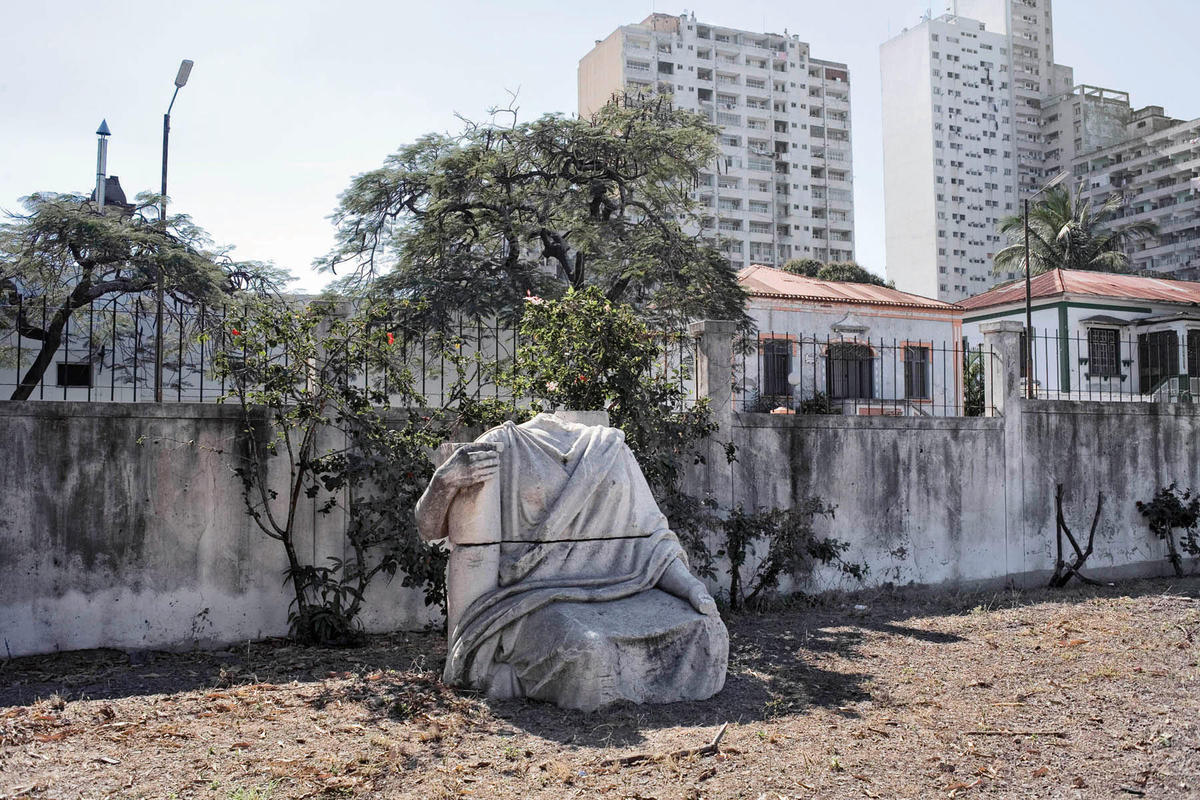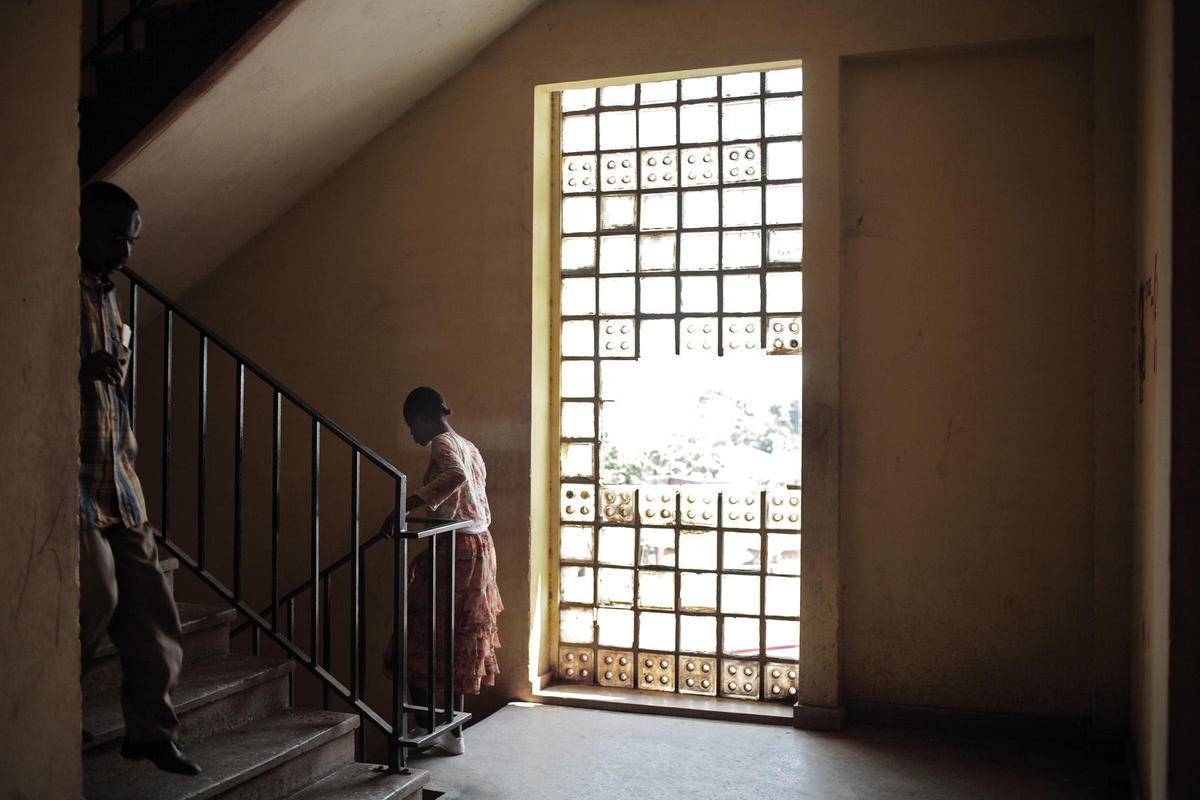
Cambridge
Guy Tillim: Avenue Patrice Lumumba
Peabody Museum of Archaeology and Ethnology
April 29–September 8, 2009
Guy Tillim’s ‘Avenue Patrice Lumumba,’ recently on display at Harvard University’s Peabody Museum, was a photographic reckoning with the entwined legacies of colonialism and modernism in a number of African countries, chiefly Mozambique, Angola, and the Democratic Republic of the Congo. The exhibition was simple and spare: about twenty large, unframed images in a small gallery space, with Tillim’s artist’s statement reproduced on the wall.
Tillim’s photographs depicted cities — seemingly derelict government buildings, gigantic apartment complexes, empty courtyards, collapsed monuments, and crumbling swimming pools. The color palette was unnaturally unsaturated; everything looked bleached or jaundiced and sick. Sunlight was never yellow, leaves were never truly green, nor was the sky blue. At a high school pool in Lubumbashi, Congo, trees sprouted through the concrete flooring. The palatial main hall of the Grande Hotel in Beira, Mozambique, was a stripped-out cavern with a slab staircase; its large semicircular roof deck was decorated with drying laundry and buckets collecting rainwater. The painted pastel concrete used in nearly every building had darkened with mold, and it seemed the architecture itself was being eaten alive.

Though there were signs of habitation — cars, graffiti, advertisements, piles of trash — there were few people in these images; the occasional human presence seemed almost surreal. Tillim found administrative offices for government bureaucracies, often staffed with one lonely agent and a typewriter, flanked by shelving packed with yellowed, crumbling paperwork. Sometimes a few agents sat at adjacent desks, watched over forlornly by a faded presidential portrait. An image of the court records room in Lubumbashi was a précis of hopeless bureaucratic futility: thousands of faded legal documents, bundled with twine, sat piled up on an endless shelf, an archive without any apparent logic or system.
All the buildings partook in a generic, late-modernist style of poured concrete and block geometries, whether apartment complex, office tower, or hotel. Though the image titles included the locations, the persistent color scheme and level of decay gave them all an odd, sad cohesion: everything, everywhere, looked the same. But Tillim, in his statement, insisted that the work was not simply a survey of anonymous architecture: “These photographs are not collapsed histories of post-colonial African states or a meditation on aspects of late-modernist-era colonial structures, but a walk through avenues of dreams. Patrice Lumumba’s dream, his nationalism, is discernible in the structures, if one reads certain clues, as is the death of his dream, in these de facto monuments. How strange that modernism, which eschewed monument and past for nature and future, should carry such memory so well.”
This might have seemed disingenuous at first, since even a quick read of the images (many additional images appear in a book of the same title, published by the museum) suggested that it was indeed both a survey of architectural tropes and a photo essay on life in certain parts of postcolonial Africa. But his foregrounding of a national dream, of a specific narrative arc still taking place offstage, made the images more broadly resonant, even as they concentrated on the localized specifics by which this narrative manifests itself: various strata of collapsing ruin, the collision of disparate technologies, adaptive reuse of space. In his equation of modernist buildings with “de facto monuments,” Tillim revealed the core of his project: that these cities seem to have moved from dream to monument without any stage in between — not unlike Lumumba himself, Congo’s fiery first prime minister, murdered barely six months into his term. Colonialism and modernism appeared as sibling catastrophes. In many images, they were quite literally stacked on top of each other, as when a giant statue of the colonial governor of Quelimane, Mozambique, lay toppled in a concrete courtyard, cradling a used tire for support.
Perhaps Tillim’s recent inclusion in prominent art exhibitions (Documenta 12, the São Paulo Biennial) signals a curatorial effort to reassess the value and artistic status of documentary work when practiced without the detachment or skepticism that have lately defined its inclusion in the art world. Tillim himself, Harvard’s first Robert Gardner Fellow, seems largely unconcerned with that discussion. His claim to avoid fetishizing postcolonial societies and their collapsing architectures was borne out by his focus on daily human particulars. These buildings were still in use, and the people found working in them were not staged or placed, nor unwittingly participating. But if Tillim found the traces of colonialism buried just beneath a collapsed modernity, perhaps the visual logic of his camera frame represented some kind of coming third layer: the disembodied, digitized era of a new technological modernity that flattens cultural difference more effectively than either violence or architecture. For these states, it would be yet another arrival at a future without a past to support it.